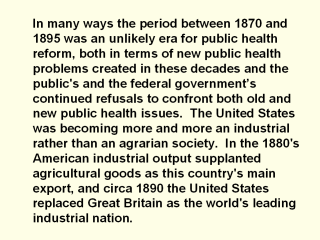 |
This rapid
industrial growth in the post-Civil War period was accomplished with almost
no concern for the public health consequences of such rapid industrial
growth. After 1870 the United States began using coal as its main energy
source, thus creating major air pollution problems in all large cities. The
nature of the American factory system encouraged centralization of
production in or near urban areas creating bad living environments, as
workers were crammed into crowded housing near their plants. NYC in 1901
Waterways in or near cities were polluted by industrial waste dumping, while
slaughterhouses and packing houses dumped refuse on vacant city blocks, and
the tanning industry washed hides in the urban drinking water reservoirs.
The new factories created terrible noise pollution for both workers and
neighbors, a health hazard not understood until recently. |
